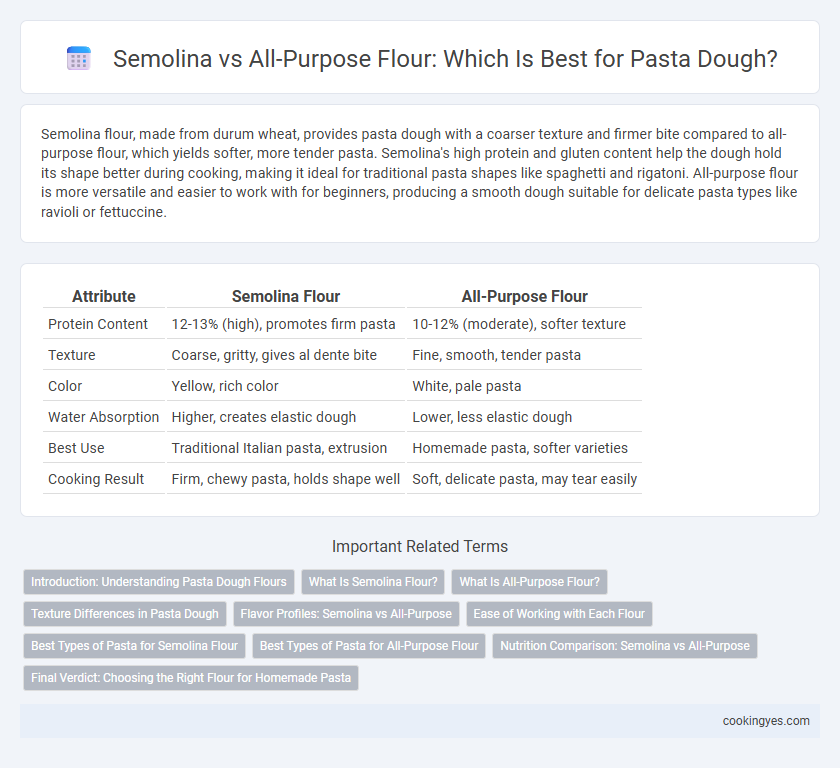Semolina flour, made from durum wheat, provides pasta dough with a coarser texture and firmer bite compared to all-purpose flour, which yields softer, more tender pasta. Semolina's high protein and gluten content help the dough hold its shape better during cooking, making it ideal for traditional pasta shapes like spaghetti and rigatoni. All-purpose flour is more versatile and easier to work with for beginners, producing a smooth dough suitable for delicate pasta types like ravioli or fettuccine.
Table of Comparison
| Attribute | Semolina Flour | All-Purpose Flour |
|---|---|---|
| Protein Content | 12-13% (high), promotes firm pasta | 10-12% (moderate), softer texture |
| Texture | Coarse, gritty, gives al dente bite | Fine, smooth, tender pasta |
| Color | Yellow, rich color | White, pale pasta |
| Water Absorption | Higher, creates elastic dough | Lower, less elastic dough |
| Best Use | Traditional Italian pasta, extrusion | Homemade pasta, softer varieties |
| Cooking Result | Firm, chewy pasta, holds shape well | Soft, delicate pasta, may tear easily |
Introduction: Understanding Pasta Dough Flours
Semolina flour, made from durum wheat, offers a high protein content and a coarse texture ideal for sturdy, al dente pasta dough, while all-purpose flour provides a softer, more versatile base with moderate protein levels for tender pasta. The unique gluten structure in semolina promotes elasticity and chewiness, essential for traditional pasta shapes and durability during cooking, contrasting with the more delicate texture achieved using all-purpose flour. Selecting the proper flour is crucial for optimal pasta dough consistency, affecting both the taste and the cooking performance of the finished dish.
What Is Semolina Flour?
Semolina flour, derived from durum wheat, is a coarser grain with a high protein and gluten content, making it ideal for traditional pasta dough due to its firm texture and ability to hold shape during cooking. Compared to all-purpose flour, semolina produces pasta that is more resilient and has a slightly nutty flavor, enhancing the overall eating experience. Its granular consistency also absorbs water differently, resulting in dough that is easier to work with when forming classic pasta shapes.
What Is All-Purpose Flour?
All-purpose flour is a versatile wheat flour made from a blend of hard and soft wheat, with moderate protein content ranging from 10 to 12 percent, making it suitable for various baking needs. Unlike semolina, which is coarse and high in gluten, all-purpose flour produces a softer, more elastic pasta dough that is easier to handle but may lack the firm texture typical of traditional pasta. Its fine texture and balanced protein level allow for a flexible dough that absorbs water differently than semolina, impacting the final pasta's bite and cooking time.
Texture Differences in Pasta Dough
Semolina flour produces a coarser, grainier texture in pasta dough, resulting in a firmer bite and better sauce adherence. All-purpose flour creates a smoother, more elastic dough with a softer, silkier finished pasta. The higher protein and gluten content in semolina enhance the dough's durability and chewiness compared to the more tender texture from all-purpose flour.
Flavor Profiles: Semolina vs All-Purpose
Semolina flour, made from durum wheat, imparts a nutty, slightly sweet flavor with a firm texture to pasta dough, enhancing its traditional Italian taste. All-purpose flour offers a more neutral, mild flavor that serves as a versatile base but lacks the distinct character of semolina. The choice between semolina and all-purpose flour significantly affects the flavor profile and texture complexity of homemade pasta dishes.
Ease of Working with Each Flour
Semolina flour, known for its coarser texture and high protein content, creates a dough that can be slightly firmer and more elastic, requiring more effort to knead but providing excellent bite and structure in pasta. All-purpose flour produces a softer, more pliable dough that is easier to roll out and shape, making it ideal for beginners or quick recipes. The choice between semolina and all-purpose flour ultimately impacts the dough's handling, with semolina offering a sturdier consistency and all-purpose flour delivering smooth workability.
Best Types of Pasta for Semolina Flour
Semolina flour, derived from durum wheat, is ideal for making traditional Italian pasta varieties like spaghetti, fettuccine, and penne due to its high protein content and coarse texture, which provide a firm bite and excellent water absorption. Unlike all-purpose flour, semolina flour maintains pasta shape during cooking and yields a denser, chewier texture preferred in dried and fresh pasta recipes. Pasta types such as orecchiette and cavatelli particularly benefit from semolina's granular consistency, ensuring superior structure and a satisfying mouthfeel.
Best Types of Pasta for All-Purpose Flour
All-purpose flour is ideal for softer pasta varieties like gnocchi, fettuccine, and egg noodles due to its balanced protein content, which provides a tender yet elastic dough. Unlike semolina flour, which yields a coarser texture perfect for robust shapes like orecchiette and cavatelli, all-purpose flour creates smoother strands suitable for delicate sauces. Its versatility and easy handling make all-purpose flour a preferred choice for homemade pasta recipes requiring pliable and smooth dough.
Nutrition Comparison: Semolina vs All-Purpose
Semolina flour, derived from durum wheat, contains higher protein content and more gluten, which contributes to pasta's firm texture and improved nutritional value compared to all-purpose flour. It also provides more fiber, vitamins, and minerals such as iron and B vitamins, enhancing the pasta's overall health benefits. All-purpose flour, made from a blend of hard and soft wheat, has lower protein and fiber levels, resulting in softer pasta with fewer nutrients per serving.
Final Verdict: Choosing the Right Flour for Homemade Pasta
Semolina flour offers a coarse texture and higher protein content, creating pasta dough that is firm and holds its shape well during cooking. All-purpose flour produces a softer dough with a smoother texture, ideal for delicate pasta shapes like fettuccine or ravioli. For authentic, sturdy pasta with a distinct bite, semolina is preferred, while all-purpose flour suits versatile, tender pasta recipes.
Semolina vs all-purpose flour for pasta dough Infographic

 cookingyes.com
cookingyes.com